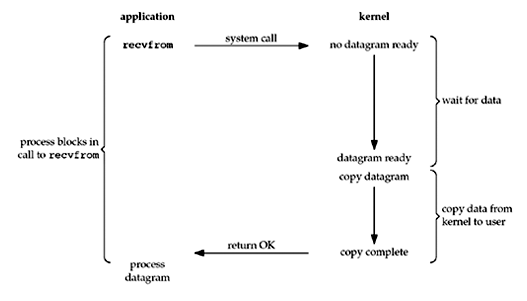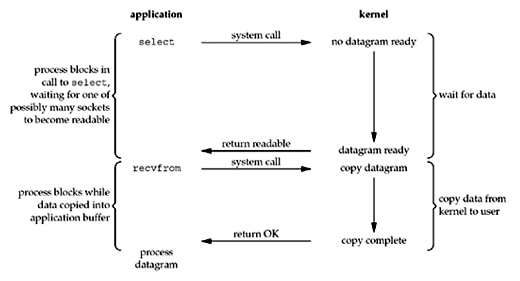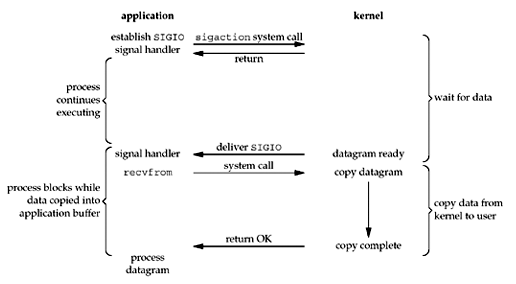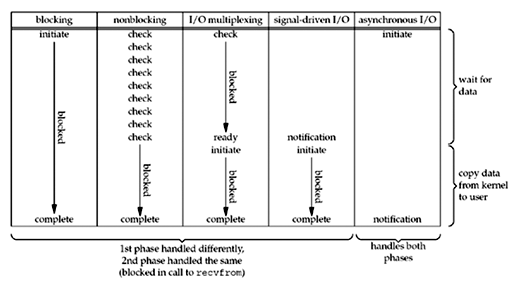I/O 模型 通常输入操作的两个阶段:
等待数据准备好
从内核缓存中读取数据
对于网络(套接字)上的输入操作这两个阶段分别为:
等待数据从网络到达,并将等待分组的数据(如果有的话)复制到内核中的缓冲区
将数据从内核缓冲区复制到应用进程缓冲区
实际上,第一个阶段在时间上的消耗远远要大于第二个阶段,所以操作系统历史演进的过程中也是抓主要矛盾,用各种手段解决第一阶段的时间消耗问题(事实上也就是下面5种I/O模型的前4种都是用这种思路解决问题)。
以下的图片来自 UNIX网络编程 卷1:套接字联网API
阻塞I/O(blocking I/O)
非阻塞I/O(Non-blocking I/O)
I/O 复用(select poll)
信号驱动的I/O(SIGIO)
异步I/O(POSIX 的aio_系列函数)
五种I/O模型的对比
用生活中的例子来类比这个I/O模型 举一个在餐厅点餐的例子,餐厅点餐会分为两个阶段:
排队等待点餐
点餐、付款以及等餐
对应的就是输入操作的两个阶段:
等待数据准备好
从内核缓存中读取数据
那么这5种I/O模型对应的就是下面的点餐模式:
阻塞I/O
非阻塞I/O
I/O 复用(select poll epoll)
信号驱动的I/O(SIGIO)
异步I/O
I/O复用模型内部实现细节 在C10k问题提出之前,互联网应用在单位时间处理的连接数还不够大,因此基于select和poll的I/O复用模型还是足够应付的,select(1984) -> poll(1997) -> epoll(2002)
异步编程在各个技术生态的发展 Java stack 几个容易搞混淆的技术
Tomcat、Jetty、Netty、WebFlux
WebFlux 是Spring 框架中的web框架模块,支持以Reactive Stream的方式进行网络编程。
Spring WebFlux framework choice
异步在JavaEE标准的演进
Servlet 3.0 之前版本: 仅支持同步处理请求,并且只支持Blocking IO
Servlet 3.0 版本 : 支持异步处理请求,但是只支持Blocking IO
Servlet 3.1、4.0 版本 : 支持异步处理请求,同时支持NoBlocking IO
Wikipedia - Java Servlet
在Android生态中的应用 我们都知道,在Android中有很重要的一块知识点是需要和事件以及消息打交道,这里就离不开事件循环,我们都知道任何的一个事件循环都是通过一个类似下面形式的循环实现的:
1 2 3 4 5 6 for (;;;) { message = obtainMessage(); dispatchMessage(message); }
当然Android中也不例外,从Looper的源代码我们就可以探知一二(为了方便查看主要逻辑,我将与本主题无关的代码以\\ ......略去):
1 2 3 4 5 6 7 8 9 10 11 12 13 14 15 16 17 18 19 20 21 22 23 24 25 26 27 28 29 30 31 32 33 34 35 36 37 38 39 40 41 42 43 44 public static void loop () { final Looper me = myLooper(); if (me == null ) { throw new RuntimeException ("No Looper; Looper.prepare() wasn't called on this thread." ); } final MessageQueue queue = me.mQueue; for (;;) { Message msg = queue.next(); if (msg == null ) { return ; } try { msg.target.dispatchMessage(msg); if (observer != null ) { observer.messageDispatched(token, msg); } dispatchEnd = needEndTime ? SystemClock.uptimeMillis() : 0 ; } catch (Exception exception) { if (observer != null ) { observer.dispatchingThrewException(token, msg, exception); } throw exception; } finally { ThreadLocalWorkSource.restore(origWorkSource); if (traceTag != 0 ) { Trace.traceEnd(traceTag); } } msg.recycleUnchecked(); } }
我们注意到MessageQueue的对象queue在for循环体内有调用方法next(), 而且在代码注释中有提到// might block, 那么到底是怎样block住的呢, 我们需要看下MessageQueue中next方法的内部实现:
1 2 3 4 5 6 7 8 9 10 11 12 13 14 15 16 17 18 19 20 21 22 23 24 @UnsupportedAppUsage Message next () { final long ptr = mPtr; if (ptr == 0 ) { return null ; } for (;;) { nativePollOnce(ptr, nextPollTimeoutMillis); synchronized (this ) { } } }
起关键作用的就是这个 nativePollOnce方法,到底这个native的方法做了什么使得这个for循环可以不占用CPU时钟block住呢?Android Code Search 中查找nativePollOnce的jni定义找到了这样的定义android / platform / frameworks / base / master / . / core / jni / android_os_MessageQueue.cpp:
1 2 3 4 5 6 7 8 9 10 11 12 13 14 15 16 17 18 19 20 21 22 23 24 25 26 27 28 29 30 31 32 33 34 35 36 37 38 39 40 41 42 43 44 45 46 47 48 49 50 51 52 53 54 55 56 57 58 59 60 61 62 63 64 65 66 67 68 69 70 71 72 73 74 75 76 77 78 79 80 81 82 83 84 85 86 87 88 89 90 91 92 93 94 95 96 97 #define LOG_TAG "MessageQueue-JNI" #include <nativehelper/JNIHelp.h> #include <android_runtime/AndroidRuntime.h> #include <utils/Looper.h> #include <utils/Log.h> #include "android_os_MessageQueue.h" #include "core_jni_helpers.h" namespace android {static struct { jfieldID mPtr; jmethodID dispatchEvents; } gMessageQueueClassInfo; static const int CALLBACK_EVENT_INPUT = 1 << 0 ;static const int CALLBACK_EVENT_OUTPUT = 1 << 1 ;static const int CALLBACK_EVENT_ERROR = 1 << 2 ;class NativeMessageQueue : public MessageQueue, public LooperCallback {public : NativeMessageQueue (); virtual ~NativeMessageQueue (); virtual void raiseException (JNIEnv* env, const char * msg, jthrowable exceptionObj) void pollOnce (JNIEnv* env, jobject obj, int timeoutMillis) void wake () void setFileDescriptorEvents (int fd, int events) virtual int handleEvent (int fd, int events, void * data) private : JNIEnv* mPollEnv; jobject mPollObj; jthrowable mExceptionObj; }; NativeMessageQueue::NativeMessageQueue () : mPollEnv (NULL ), mPollObj (NULL ), mExceptionObj (NULL ) { mLooper = Looper::getForThread (); if (mLooper == NULL ) { mLooper = new Looper (false ); Looper::setForThread (mLooper); } } NativeMessageQueue::~NativeMessageQueue () { } void NativeMessageQueue::pollOnce (JNIEnv* env, jobject pollObj, int timeoutMillis) mPollEnv = env; mPollObj = pollObj; mLooper->pollOnce (timeoutMillis); mPollObj = NULL ; mPollEnv = NULL ; if (mExceptionObj) { env->Throw (mExceptionObj); env->DeleteLocalRef (mExceptionObj); mExceptionObj = NULL ; } } void NativeMessageQueue::wake () mLooper->wake (); } static void android_os_MessageQueue_nativePollOnce (JNIEnv* env, jobject obj, jlong ptr, jint timeoutMillis) NativeMessageQueue* nativeMessageQueue = reinterpret_cast <NativeMessageQueue*>(ptr); nativeMessageQueue->pollOnce (env, obj, timeoutMillis); } static void android_os_MessageQueue_nativeWake (JNIEnv* env, jclass clazz, jlong ptr) NativeMessageQueue* nativeMessageQueue = reinterpret_cast <NativeMessageQueue*>(ptr); nativeMessageQueue->wake (); } static const JNINativeMethod gMessageQueueMethods[] = { { "nativeInit" , "()J" , (void *)android_os_MessageQueue_nativeInit }, { "nativeDestroy" , "(J)V" , (void *)android_os_MessageQueue_nativeDestroy }, { "nativePollOnce" , "(JI)V" , (void *)android_os_MessageQueue_nativePollOnce }, { "nativeWake" , "(J)V" , (void *)android_os_MessageQueue_nativeWake }, { "nativeIsPolling" , "(J)Z" , (void *)android_os_MessageQueue_nativeIsPolling }, { "nativeSetFileDescriptorEvents" , "(JII)V" , (void *)android_os_MessageQueue_nativeSetFileDescriptorEvents }, }; int register_android_os_MessageQueue (JNIEnv* env) int res = RegisterMethodsOrDie (env, "android/os/MessageQueue" , gMessageQueueMethods, NELEM (gMessageQueueMethods)); jclass clazz = FindClassOrDie (env, "android/os/MessageQueue" ); gMessageQueueClassInfo.mPtr = GetFieldIDOrDie (env, clazz, "mPtr" , "J" ); gMessageQueueClassInfo.dispatchEvents = GetMethodIDOrDie (env, clazz, "dispatchEvents" , "(II)I" ); return res; } }
完整代码参见 https://cs.android.com | android_os_MessageQueue.cpp
为了便于说明我将与本话题无关的代码使用// ......进行了处理,实际上这部分代码也只是JNI实现的Native方法注册部分,更多的实现细节还需要查看<utils/Looper.h>对应的实现 https://cs.android.com | Looper.cpp
看到源代码中的第一行注释,我们好像终于知道了些内部细节:
1 2 3 4 5 6 7 8 9 10 11 12 13 14 15 16 17 #define LOG_TAG "Looper" #define DEBUG_POLL_AND_WAKE 0 #define DEBUG_CALLBACKS 0 #include <utils/Looper.h> #include <sys/eventfd.h> #include <cinttypes>
原来Android 的Looper内部是基于epoll这个IO模型实现的。pollOnce方法为什么能够等待下一个消息的到来而不让CPU空转,这里有一篇文章做了很好的解释 Stackoverflow - android - what is message queue native poll once in android?
Python 各种 CGI 是什么,他们与servlet又有什么关系 CGI通俗的来理解就是web server 与服务器上处理请求的程序之间的统一接口标准Wikipedia - Common Gateway Interface 。
当然上面说的是一个统一接口集,到具体的实现上其实有很多种:
后来Python在抛弃了语言的通用性基础上提出了
WSGI - web server与Python语言实现的应用服务标准
标准和协议的内容由PEP-3333 规定。
当然随着Python提出自己的标准,其他语言也陆续提出类似的标准Wikipedia - WSGI - see also
当然Java EE 也有规定自己的接口标准,这个标准在JavaEE一系列标准中叫servlet,当然servlet是基于线程建立的连接模型。
Go Golang build-in runtime 包中提供netpoll的epoll实现:
golang.org - Source file src/runtime/netpoll_epoll.go
参考文章 UNIX网络编程 卷1:套接字联网API
Shichao’s Notes - Unix Network Programming
Thousands of Threads and Blocking I/O
Java servlet async
Spring Framework - Web on Reactive Stack
Java EE - Servlet Nonblocking I/O sample
Async IO on Linux: select, poll, and epoll
Stackoverflow - Why is epoll faster than select?
Three mechanisms for IO multiplexing Select, Poll, Epoll
简书 - nginx的epoll
Wikipedia - Epoll






